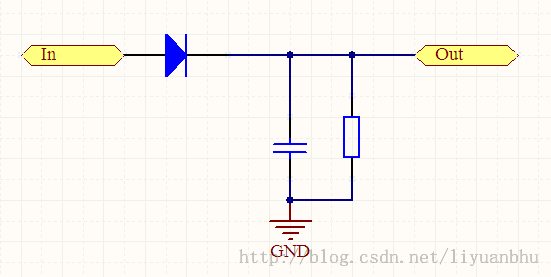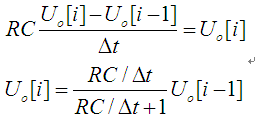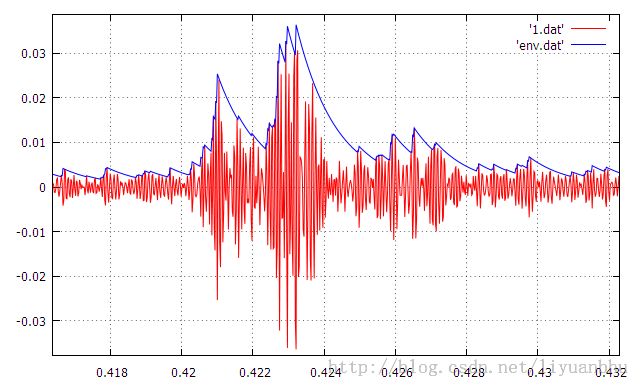一个简单的波形包络提取算法
最近做了一个项目来提取语音信号包络波形,因此,花一些时间来研究各种包络提取算法。
所谓包络检测被称为振幅解调,在许多领域都有重要的应用。它假设载波信号被确定,所以,通常的方式同步解调,优选以这样的方式的SNR,混合信号噪声抑制最强。的叫法。在信号检測领域,这样的方式通常称为“相敏检波”。锁相放大器(Lock-in Amplifier)就是这样的方式最典型的样例。
假设载波比較乱。就像我如今的应用场景。要提取噪声的幅度随时间变化的规律,那么包络检波法会更适宜。我这里的代码就是採用的包络检波法。
包络检波法的基本原理能够看以下这个电路图。这个是最主要的半波包络检波。

当 Ui(t) > Uo(t-) 时 Uo(t) = Ui(t)
当 Ui(t) < Uo(t-) 时
RC dUo/dt = Uo
化成差分方程为:

把这个过程用程序来实现就有了以下的代码。
/**
* 包络检波。模拟了硬件半波检波的过程
* rc = 0 时初始化
**/
double env_1(double x, double rct)
{
static double old_y = 0.0;
if(rct == 0.0)
{
old_y = 0.0;
}
else
{
if(x > old_y)
{
old_y = x;
}
else
{
old_y *= rct / ( rct + 1 );
}
}
return old_y;
}
void env_2(double x[], double y[], int N, double rct)
{
double xx = 0.0;
int i;
y[0] = fabs(x[0]);
for(i = 1; i < N; i++)
{
if( x[i] > y[i-1])
{
y[i] = x[i];
}
else
{
y[i] = y[i-1] * rct / ( rct + 1 );
}
}
}
上面是半波检測的代码,仅仅要略微添加几行。就能实现全波检測。
/**
* 包络检波,模拟了硬件全波检波的过程
* rc = 0 时初始化
**/
double env_3(double x, double rct)
{
static double old_y = 0.0;
if(rct == 0.0)
{
old_y = 0.0;
}
else
{
x = fabs(x);
if(x > old_y)
{
old_y = x;
}
else
{
old_y *= rct / ( rct + 1 );
}
}
return old_y;
}
void env_4(double x[], double y[], int N, double rct)
{
double xx = 0.0;
int i;
y[0] = fabs(x[0]);
for(i = 1; i < N; i++)
{
xx = fabs(x[i]);
if( xx > y[i-1])
{
y[i] = xx;
}
else
{
y[i] = y[i-1] * rct / ( rct + 1 );
}
}
}
这个代码中有个參数 rct,相应的是硬件电路中的RC时间常数,要依据待检測的包络信号的频带来确定。
以下是用这个代码实际提取包络的算例。能够看出这个代码的效果还是蛮不错的。
(比採用Hilbert 变换得到的结果还要好)


以下是C++的代码,功能同样。
/**
* 包络检波功能,模拟了硬件半波检波和全波检波功能
*/
class env_detect
{
private:
double m_rct;
double m_old;
public:
env_detect(){m_rct = 100.0, m_old = 0.0;};
void init(double rct);
double env_half(double in);
void env_half(double in[], double out[], int N);
double env_full(double in);
void env_full(double in[], double out[], int N);
};
/** \brief 初始化
*
* \param rct 为RC低通滤波的时间常数
* \return
*/
void env_detect::init(double rct)
{
m_rct = rct;
m_old = 0.0;
}
/** \brief 半波包络检測
*
* \param in 输入波形。每次传入一个数据点
* \return 输出波形
*/
double env_detect::env_half(double in)
{
if(in > m_old)
{
m_old = in;
}
else
{
m_old *= m_rct / ( m_rct + 1 );
}
return m_old;
}
/** \brief 半波包络检測
*
* \param in[] 输入波形
* \param N 数组的点数
* \param out[] 输出波形
* \return
*/
void env_detect::env_half(double in[], double out[], int N)
{
for(int i = 0; i < N; i++)
{
if( in[i] > m_old)
{
m_old = in[i];
out[i] = m_old;
}
else
{
m_old *= m_rct / ( m_rct + 1 );
out[i] = m_old;
}
}
}
/** \brief 全波包络检測
*
* \param in 输入波形,每次传入一个数据点
* \return 输出波形
*/
double env_detect::env_full(double in)
{
double abs_in = fabs(in);
if(abs_in > m_old)
{
m_old = abs_in;
}
else
{
m_old *= m_rct / ( m_rct + 1 );
}
return m_old;
}
/** \brief 全波包络检測
*
* \param in[] 输入波形
* \param N 数组的点数
* \param out[] 输出波形
* \return
*/
void env_detect::env_full(double in[], double out[], int N)
{
double abs_in;
for(int i = 0; i < N; i++)
{
abs_in = fabs(in[i]);
if( abs_in > m_old)
{
m_old = abs_in;
out[i] = m_old;
}
else
{
m_old *= m_rct / ( m_rct + 1 );
out[i] = m_old;
}
}
}